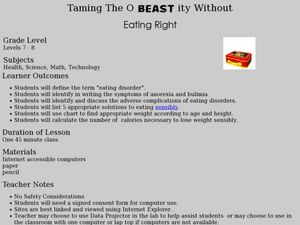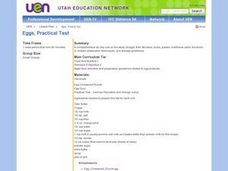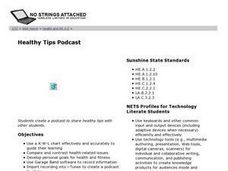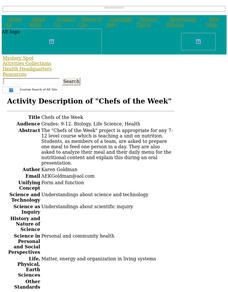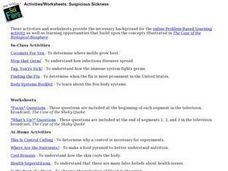Curated OER
There's a Rainbow on My Plate
Students complete a variety of activities to learn about the importance of eating fruits and vegetables. In this healthy eating lesson, students complete activity sheets, make a wall poster, create a take home flyer, participate in a...
Curated OER
Food Pyramid
Students construct food pyramids by painting shoe boxes and using them to respresent different food groups. They cut out and paste pictures of the respresentative foods for the groups on the box sides. They compare their diets to the...
Curated OER
Taming the O-BEAST-ITY Without Eating Right
Students use the Internet to find out about eating disorders and maintaining a healthy weight. In this eating disorders lesson, students identify eating disorders such as anorexia and bulimia and discuss complications. Students discover...
Curated OER
Food for Spaceflight
When astronauts get hungry in outer space, they can't just call and have a pizza delivered. In order to gain an appreciation for the challenges associated with space travel, young learners are given the task of selecting,...
Curated OER
Eggs, Baked Eggs Lab, Day 2
Students examine the structure, sizes and nutritional value of eggs. After completing a word search, they participate in a lab in which they make baked eggs with bacon. To end the lesson, they test their final product and complete a lab...
Curated OER
Family Life Cycle - Breakfast Lab
Pupils review the nutritional needs of various age groups. In groups, they plan a breakfast meal for different age groups and spend time making the foods. To end the instructional activity, they serve the food to their classmates for...
Curated OER
Eggs, Practical Test
Third graders explore the structure, size, grades, nutritional function, preparation techniques and storage guidelines of eggs. They prepare German Pancakes and Orange Julius.
Curated OER
Food Pyramid
First graders examine the different levels of the food pyramid and plan a healthy meal. They discuss the food pyramid and read about nutrition using a variety of resources. Using Kidspiration computer software, they plan a...
Curated OER
Healthy Tips Podcast
Students create a health-based podcast for peers using prior knowledge, internet research, and KWL charts. This activity is adaptable for different health topics and age levels.
Curated OER
Family Life Cycle - Children's Lab
Learners review how their nutritional needs change over time. In groups, they design their own menu in which they get all the nutrients they need. To end the lesson, they share their foods with the class and complete a wordsearch...
Curated OER
Eggs, Baked Eggs
Students explore eggs including their structure, sizes, grades, nutritional value, functions in recipes, preparation techniques, and storage guidelines.
Curated OER
Chefs of the Week
Learners, as members of a team, are asked to prepare one meal to feed one person in a day. They analyze their meal and their daily menu for the nutritional content and explain this during an oral presentation.
Curated OER
Pies: A Practical Application
Students participate in making a pie. They are to discuss the nutritional value and the different types of pies. They also answer questions from the teacher about fat and they complete a pie evaluation form.
Curated OER
Food Security/Insecurity
Students gain awareness of global patterns of food distribution. They are introduced to the concepts of food security and food insecurity. Pupils investigate the nutritional status of others around the world using information from the...
Curated OER
The Great Depression: Eating on a Shoestring
Students explore the realities of feeding a family on a very limited budget by comparing the cost of living in the 1930s to the cost of living today. Using primary documents and technology to make the comparison, they identify the impact...
Curated OER
Learning about Infectious Diseases
All of the activities and worksheets in this unit relate to learning about how infectious diseases spread & how the body deals with them. There is a collection of problem-based learning activities, as well very useful at-home...
Curated OER
Making Molecular Models
In these creative hands-on activities, students construct several different molecular models that represent substances that play an essential role in our nutritional needs. Using gum drops and toothpicks, students design the models....
Curated OER
Food and Your Body -- How to Maintain a Healthy Diet
Students examine the different food groups on the food pyramid. In groups, they discover the proper amount to eat from each food group and how to prepare healthy meals. They keep a food journal and calculate the amount of calories they...
Curated OER
Biomolecules
Students perform an experiment in which they test foods for the presence of proteins, carbohydrates, and lipids. They identify the molecular structure of each type of biomolecule and then discuss how biomolecules relate to nutrition and...
Curated OER
The Circulatory System - Part I
First graders consider what effect their behavior has on their health. Students make a fist to indicate the size of his/her heart. They complete a worksheet on the heart, coloring the arteries red and the veins blue.
Curated OER
Healthy Food Makes Healthy Body
Students explore the food pyramid. In this healthy eating lesson, students participate in a variety of center activities where they explore the food pyramid and the importance of making healthy food choices. Students also have the...
DocsTeach
Uncle Sam and the American Diet
Uncle Sam wants you to follow the food pyramid! Scholars analyze two images of propaganda posters the government created to promote the food pyramid. Academics complete a worksheet to understand the impact of the campaign and end the...
Achieve
Ivy Smith Grows Up
Babies grow at an incredible rate! Demonstrate how to model growth using a linear function. Learners build the function from two data points, and then use the function to make predictions.
ProCon
Vegetarianism
What do Mike Tyson, Ellen DeGeneres, and Paul McCartney have in common? They're all famous vegetarians. Using the resource, scholars learn about the pros and cons of eating a vegetarian diet. They read a fascinating history of...




